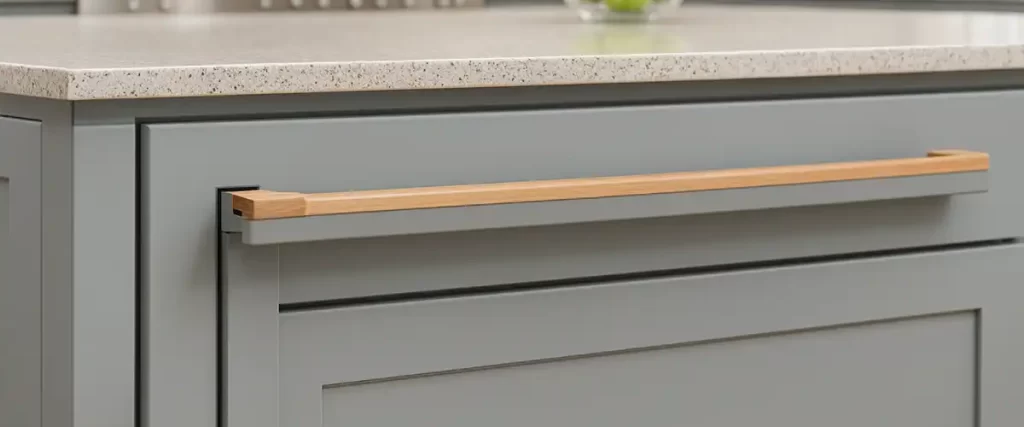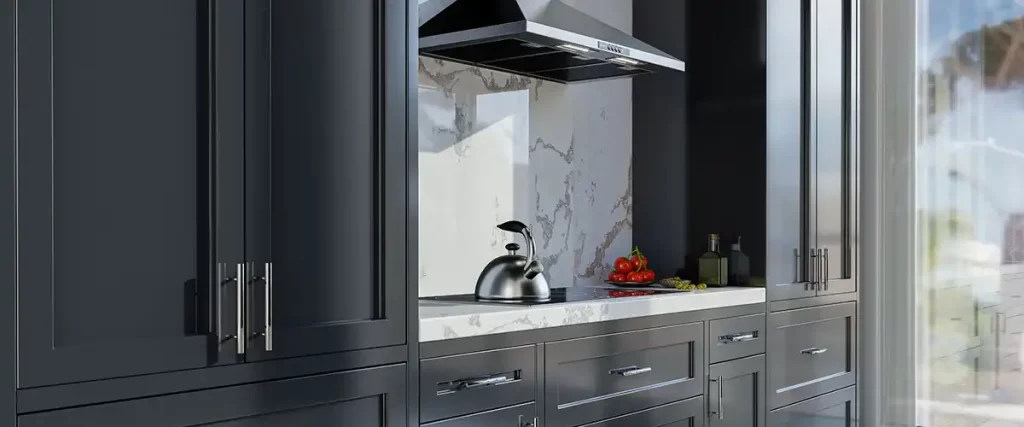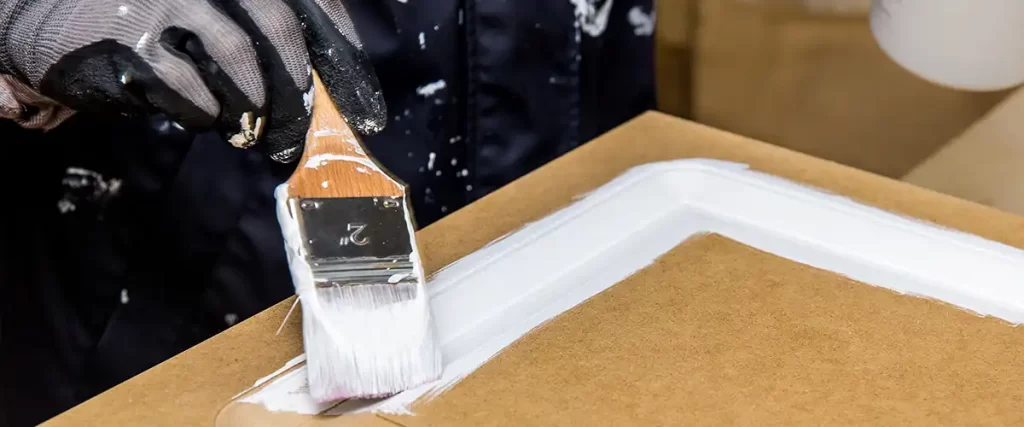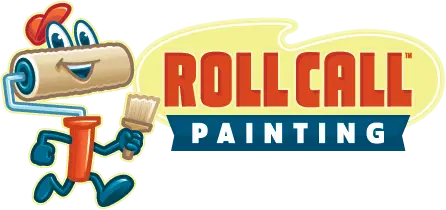Painting your kitchen cabinets is one of the most impactful ways to refresh your kitchen without the cost of a full remodel.
But the success of that transformation depends heavily on the paint you use. The best paint for kitchen cabinets will give you a clean, smooth finish that holds up to daily wear, resisting chips, scratches, grease, and frequent cleaning.
This breakdown highlights the top paint options, recommended finishes, and key details that matter when planning a cabinet refresh, especially in a busy kitchen.

What Really Matters
- Top cabinet paints: Benjamin Moore Advance and Sherwin-Williams Emerald Urethane Trim Enamel are widely recommended for their durability, smooth finish, and professional-level results.
- Best for DIYers: Rust-Oleum Cabinet Transformations Kit and General Finishes Milk Paint (with a topcoat) are user-friendly and produce good results with careful prep.
- Ideal finish: Semi-gloss offers the best balance of durability, cleanability, and appearance. Satin is softer and hides imperfections; high-gloss is sleek but shows more flaws.
- Paint types to consider: Waterborne alkyds (hybrid paints) are the top choice for combining ease of use with long-lasting performance.
- What to avoid: Wall paints, low-quality primers, or skipping prep steps. These lead to poor adhesion, chipping, and uneven results.
- Color trends: White, greige, and navy remain popular. Test samples in your space before deciding.
- Pro vs. DIY: Professionals use HVLP sprayers and cabinet-grade products to achieve a flawless, long-lasting finish. Something difficult to match with brushes or rollers at home.
Best Paints for a Factory-Smooth Cabinet Finish
If your goal is a sleek, professional finish that looks like it came straight from a factory, these are the paints professionals (including our team at Roll Call Painting) often rely on:
1. Benjamin Moore Advance
- Type: Waterborne Alkyd
- Performance: Advance paint self-levels beautifully, mimicking the smooth look of sprayed-on lacquer.
- Why we like it: Combines the strength of oil-based paints with the easy cleanup and lower odor of water-based. Compared to other paints, Advance paint stands out for its unique waterborne alkyd composition, which delivers a professional finish but requires longer dry times and careful re-coat scheduling.
- Best for: High-use kitchens, trim, and cabinetry.
- Finishes available: Satin, Semi-Gloss, High-Gloss
2. Sherwin-Williams Emerald Urethane Trim Enamel
- Type: Urethane-modified Alkyd
- Performance: Extremely durable and scratch-resistant.
- Why we like it: Excellent adhesion and wear resistance. Won’t yellow over time.
- Finishes available: Satin, Semi-Gloss, Gloss
3. Valspar Cabinet & Furniture Enamel
- Type: Oil-enriched water-based enamel
- Performance: Applies smoothly with little to no brush marks.
- Why we like it: Designed specifically for cabinets, easy to apply, and resists stains.
- Finish: Satin
4. Behr Alkyd Semi-Gloss Enamel
- Type: Water-based alkyd
- Performance: Hard-drying, great for high-traffic kitchens.
- Why we like it: Durable and budget-friendly, suitable for both brush or sprayer application.
- Finish: Semi-Gloss

Best Paint for Cabinets (DIY-Friendly Options)
Not everyone wants to hire a pro, and for more experienced DIYers, there are still great options on the market. Especially if you’re comfortable taking your time and following each step carefully.
Many homeowners choose to paint their own cabinets for a custom look that fits their style and budget. Using the right techniques and quality products, painted cabinets can look just as professional and durable as those finished by experts.
Keep in mind that some DIY-friendly paints require multiple coats for full coverage and long-lasting durability.
Rust-Oleum Cabinet Transformations Kit
- What it is: An all-in-one refinishing kit that includes a bond coat, decorative glaze, and a top coat. The top coat is essential for protecting the painted finish, enhancing durability, and providing a choice of sheen such as satin or matte. It helps prevent chipping and extends the life of your cabinets.
- Pros: Doesn’t require sanding or priming; very beginner-friendly.
- Cons: More forgiving than traditional paints but can still look uneven if rushed.
- Best for: Smaller kitchens or experienced DIYers with time to spare.
General Finishes Milk Paint (plus Topcoat)
- What it is: A highly rated furniture paint often used on wood cabinetry.
- Pros: Available in beautiful custom colors, matte finish.
- Cons: Needs a topcoat for durability.
- Best for: Custom cabinet looks or farmhouse-style kitchens.
Types of Paint for Kitchen Cabinets
Not all paint is created equal. Here’s how to know what you’re working with:
When choosing paint for kitchen cabinets, it’s important to understand the differences between water based paint and oil paint. Water based paint offers quick drying times, low odor, and easy cleanup, making it ideal for DIY projects.
Oil paint, on the other hand, is known for its superior durability and smooth, professional finish, though it requires longer drying times and more involved cleanup.
For raw wood or previously painted cabinets, use a high quality primer, especially a stain-blocking or shellac-based primer, to ensure proper adhesion and prevent bleed-through. This step is crucial for both new and refinished cabinetry to achieve a durable, smooth finish.
Oil-Based Paint
- Pros: Oil paint offers excellent hardness and stain resistance, with a durable, high-quality finish that often surpasses water-based alternatives.
- Cons: Oil paint produces strong fumes, has a longer drying time, and requires more difficult cleanup.
- Still relevant? Less common today due to VOC regulations but still used by some pros for its superior durability and finish.
Water-Based Acrylic or Latex Paint
- Pros: As a water based paint, it offers low odor, fast drying, and easy cleanup. Compared to oil-based paint, water based paint dries much faster and produces less odor, making it ideal for DIY projects and cabinetry.
- Cons: Slightly softer finish compared to alkyds unless you use top-tier products.
Hybrid Alkyd Paints (Waterborne Alkyds)
- Pros: Best of both worlds. Durable, smooth, and easier to work with.
- Cons: Slightly more expensive than basic latex.
- Verdict: Often considered the best paint for kitchen cabinets today.
What Sheen Is Best for Kitchen Cabinets?
Sheen plays a huge role in both appearance and cleanability:
- Semi-Gloss Finish: The top pick. A semi gloss finish reflects just enough light, hides minor imperfections, and is easy to wipe down, making it ideal for kitchen cabinets due to its durability and professional, easy-to-clean appearance.
- Satin Finish: Offers a softer look compared to a semi gloss finish, with slightly less durability but still practical. A satin finish balances durability and aesthetic appeal, providing a professional look while being easier to maintain than matte.
- High-Gloss: Very modern and bold, but shows every flaw. Great for ultra-smooth, professional finishes.
- Matte/Flat: Not recommended for cabinets due to low durability and stain resistance.

Choosing the Right Color for Kitchen Cabinets
While white remains timeless, bold cabinet colors are trending in 2025. Current interior design trends play a significant role in shaping the most popular kitchen cabinet colors, so consider how these trends might influence your choices.
Consider the following when selecting your paint color:
- Light colors (white, cream, light gray): Brighten your space and make smaller kitchens feel open.
- Dark colors (navy, black, forest green): Offer drama and contrast but may require more lighting.
- Earth tones and muted greens: Warm, versatile, and trending in both traditional and modern homes.
- Two-tone styles: Paint upper and lower cabinets in different colors for a custom, high-end feel.
Pro tip: Always test a few swatches at home before committing. Lighting conditions dramatically change how colors appear.
Budget-Friendly Options for Kitchen Cabinet Painting
Chalk paint is a go-to for DIYers thanks to its low cost and easy application. It sticks well to most surfaces, often without primer, and creates a soft, matte finish that works well in casual or modern kitchens.
Milk paint has a naturally soft, matte texture that creates a more aged, handcrafted look, especially when mixed with a bonding agent for better adhesion. It’s a good fit for older homes or kitchens with a bit of vintage character, and it’s often more affordable than traditional cabinet paints.
Acrylic and enamel cabinet paints offer a smoother, glossier finish that’s easy to clean and more durable for high-use areas. Many affordable options are designed specifically for cabinets, delivering reliable results without the premium price.
- Look for products labeled for cabinets or furniture
- Avoid regular wall paints, which may not hold up over time
- Proper prep still matters, even with budget-friendly paints
Tools & Prep: What You’ll Need
Proper prep work is crucial for achieving a smooth surface and professional finish when painting cabinet doors and flat surfaces. This includes sanding to address wood grain, ensuring even coverage and optimal paint adhesion.
Even the best paint won’t perform well if surface prep is skipped, a top cause of cabinet painting mistakes. Here’s what you need:
- Degreaser or TSP substitute
- Painter’s tape
- Drop cloths
- Screwdriver or drill
- Sandpaper (medium and fine grit)
- Sanding block
- Tack cloth or microfiber cloth
Prep Tools
- Degreaser (e.g., Krud Kutter)
- Sandpaper (120–220 grit), sanding block
- Tack cloths
- Painter’s tape
- Drop cloths
Application Tools
- High-density foam rollers
- Angled synthetic brushes
- Paint sprayer (for an even, professional finish)
- HVLP sprayer (if going pro-level)
- High-adhesion primer (BIN Shellac or Zinsser Cover Stain)
Skipping any of these steps or using the wrong products can lead to adhesion issues, streaks, or a finish that won’t last.

DIY vs. Professional Painting: What to Know
While DIY projects can be rewarding, painting kitchen cabinets is more complex than many people expect.
Common mistakes, like not sanding properly, using wall paint, or applying coats too thickly, can ruin the final result. Achieving a flawless, durable finish often requires the skills and precision of a professional painter.
- Proper surface preparation is essential for paint adhesion.
- Using the right primer prevents stains and improves durability.
- Professional painters use specialized techniques and products to deliver superior results.
Hiring a Professional Means:
- Access to commercial-grade tools and paints
- Professional painters select high-quality paints and finishes for optimal cabinet results
- Clean, even spray finishes with no brush marks
- Proper surface prep and curing
- Faster turnaround and less disruption
- A warranty to back up the work
When You’re Ready to Skip the Hassle, We’re Here to Help
At Roll Call Painting, we know how important your kitchen is to your home. Our cabinet painting service is designed to give your space a fresh, updated look without the disruption or expense of a full remodel.
What we offer:
- Free in-person estimate
- Color consultation with a professional designer
- Smooth, consistent finishes using HVLP sprayers
- Premium paints from trusted brands like Sherwin-Williams and Benjamin Moore
- 3-year warranty on all cabinet painting projects
From prep to cleanup, every detail is handled by a skilled team. You don’t have to worry about the mess, the tools, or the results.
For professional cabinet painting in Wichita, KS, call us at (316)-800-6994 or request your estimate online.
